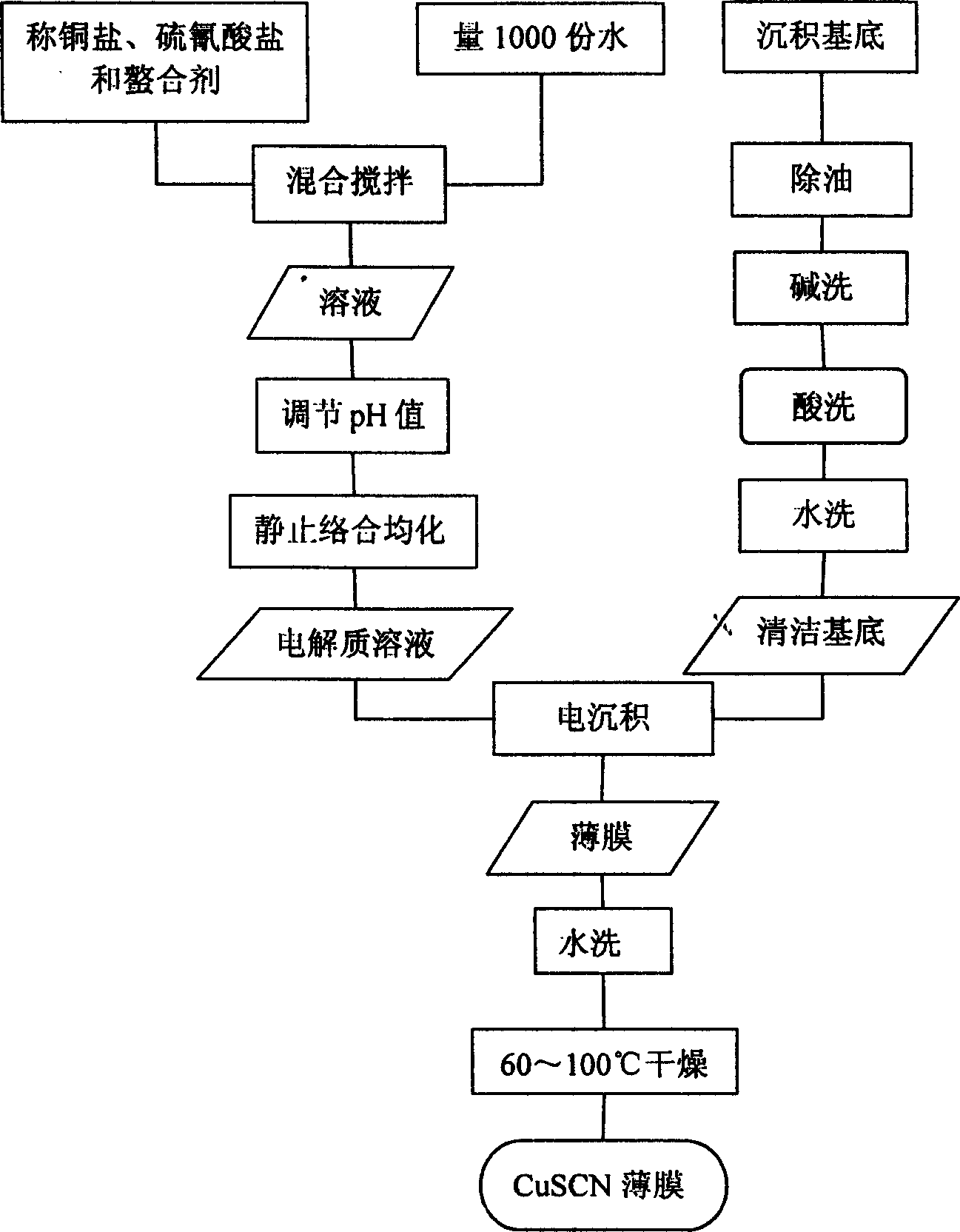Process for electrodeposition preparation of cuprous sulfocyanide film in aqueous solution
A cuprous thiocyanate and electrodeposition technology, applied in circuits, electrical components, final product manufacturing, etc., can solve the problems of low conductivity of pure organic electrolytes, dye desorption, and high prices, and achieve easy control of production processes and deposition. High efficiency and good hole filling effect
- Summary
- Abstract
- Description
- Claims
- Application Information
AI Technical Summary
Problems solved by technology
Method used
Image
Examples
example 1
[0037] Weigh 2 parts of Cu(CH 3 COO) 2 , 4 parts of disodium ethylenediaminetetraacetic acid (EDTA), 1 part of KSCN, where Cu(CH 3 COO) 2 / EDTA=0.5, Cu(CH 3 COO) 2 / KSCN=2.0; Dissolve the three substances weighed in 1000 parts of deionized aqueous solution respectively, and then adjust the pH value to 2.1; the prepared solution is ready for use after 4 hours of static complexation and homogenization. Before deposition, ethanol, 0.1M NaOH and deionized water were used to 2 o 3 -SnO 2 Conductive glass (ITO) is cleaned and dried for use. A platinum sheet was used as an auxiliary electrode, a saturated Ag / AgCl electrode was used as a reference electrode, the temperature of the solution was lowered to 15°C, and the CuSCN film was obtained by depositing at -0.6V (relative to the saturated Ag / AgCl electrode) for 5 minutes. The deposited CuSCN film was rinsed with deionized water, dried at 90°C in vacuum and then tested. It was found that the electrodeposited CuSCN film had a...
example 2
[0039] Weigh 25 parts of CuSO 4 ·5H 2 O, 11 parts of oxalic acid, 1.6 parts of NaSCN, where CuSO 4 ·5H 2 O / .oxalic acid=2.3, CuSO 4 ·5H 2 O / NaSCN=15.5; the three weighed substances were dissolved in 1000 parts of deionized aqueous solution respectively, and the pH value was adjusted to 3; the prepared solution was quiescently complexed and homogenized for 24 hours before use. Before deposition, ethanol, 0.1M NaOH and deionized water were used to 2 o 3 -SnO 2 Conductive glass (ITO) is cleaned and dried for use. A platinum sheet was used as an auxiliary electrode, a saturated Ag / AgCl electrode was used as a reference electrode, the temperature of the solution was controlled at 35°C, and a CuSCN film was deposited at -0.6V (relative to the saturated Ag / AgCl electrode) for 10 minutes. The deposited CuSCN film was rinsed with deionized water, dried at 90°C in vacuum and then tested. It is found that the electrodeposited CuSCN film has a thickness of about 2 μm, a grain siz...
example 3
[0041] Weigh 12.5 parts of CuSO respectively 4 ·5H 2 O, 10.5 parts of citric acid, 2.4 parts of KSCN, wherein CuSO 4 ·5H 2 O / oxalic acid = 1.2, CuSO 4 ·5H 2 O / KSCN=5.2; the three substances weighed were dissolved in 1000 parts of deionized aqueous solution, and the pH value was adjusted to 4.6; the prepared solution was quiescently complexed and homogenized for 24 hours before use. Before deposition, ethanol, 0.1M NaOH and deionized water were used to 2 o 3 -SnO 2 Conductive glass (ITO) is cleaned and dried for use. A platinum sheet was used as an auxiliary electrode, a saturated Ag / AgCl electrode was used as a reference electrode, the temperature of the solution was controlled at 25°C, and a CuSCN film was deposited at -0.5V (relative to the saturated Ag / AgCl electrode) for 10 minutes. The deposited CuSCN film was rinsed with deionized water, dried at 90°C in vacuum and then tested. It is found that the electrodeposited CuSCN film has a thickness of about 1 μm, a gra...
PUM
| Property | Measurement | Unit |
|---|---|---|
| Thickness | aaaaa | aaaaa |
Abstract
Description
Claims
Application Information
 Login to View More
Login to View More - R&D
- Intellectual Property
- Life Sciences
- Materials
- Tech Scout
- Unparalleled Data Quality
- Higher Quality Content
- 60% Fewer Hallucinations
Browse by: Latest US Patents, China's latest patents, Technical Efficacy Thesaurus, Application Domain, Technology Topic, Popular Technical Reports.
© 2025 PatSnap. All rights reserved.Legal|Privacy policy|Modern Slavery Act Transparency Statement|Sitemap|About US| Contact US: help@patsnap.com

